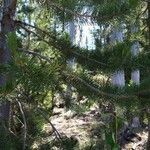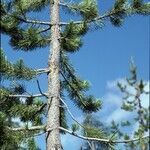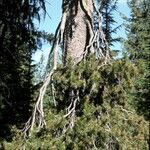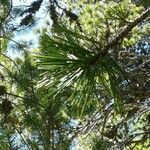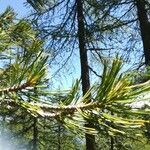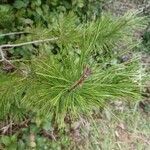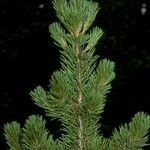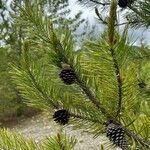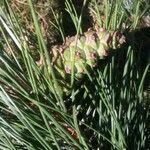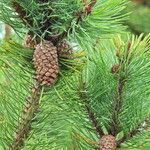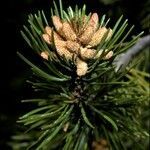Large shrub, or small to medium-sized tree (sometimes large in cultivation); habit erect or spreading. Branches straight or somewhat twisted. Bark reddish brown, grey on surface, fissured and forming small plates. Shoots brown, glabrous. Buds cylindric or cylindric-ovoid, purplish brown, strongly resinous; scales tightly appressed. Lvs 2 per fascicle, (2.5)-3.5-6.5 cm × 0.8-1.5 mm, not or somewhat twisted, usually pointed forward, generally yellowish green; resin canals median; sheath very short after first year. ♂ strobili 5-15 mm long, cylindric or broadly cylindric. Conelets sessile; scales aristate. Mature cones long-persistent, often not opening until long after maturity, subsessile, usually directed downwards or backwards, 3-6 × 2-3.5 cm, ± broad-ovoid; base asymmetric or somewhat asymmetric; apophyses shining yellowish brown or brown before maturity, ± convex; umbo with short, slender, occasionally deciduous prickle. Seed wing asymmetric but almost oblong, c. 1 cm long.
A medium sized tree. It grows to 30 m high and can be 100 cm across the trunk. The trunk is often straight with a little taper. The branches are slender and short. The needles are in bundles of 2. They are 3-7 cm long. They are usually twisted and stiff and have a very sharp point. They do not spread apart and the edges have sharp teeth. The twigs are orange-brown. The seed cones are oval and 3-6 cm long. They are purplish-brown. They are stalkless and at right angles to the branch. They may point slightly backwards. They occur in small clusters at the nodes. The remain on the tree for 10-20 years and remain closed. The scales are thickened at the tips. They have a prickle which curves backwards. The cones open when exposed to the heat from a fire. The seeds are brown and mottled. They have a ridge on one side. They are 3 mm long and with a wing.
Tree to 20 m tall. Bark dark brown, scaly. Resting buds cylindrical, strongly resinous; scales closely appressed. Leaves twisted, in bundles of 2, finely toothed, 3-7 cm long, with 2 medial resin canals; stomatal lines on all sides, glossy, dark green; basal sheath 4-6 mm long. Female cones ovoid-conical, mostly asymmetric, 2-6 cm long, opening and shedding at maturity, or persisting for 1-few years; scales cuneate, with a slender, fragile mucro. Seeds with a well-developed wing.
